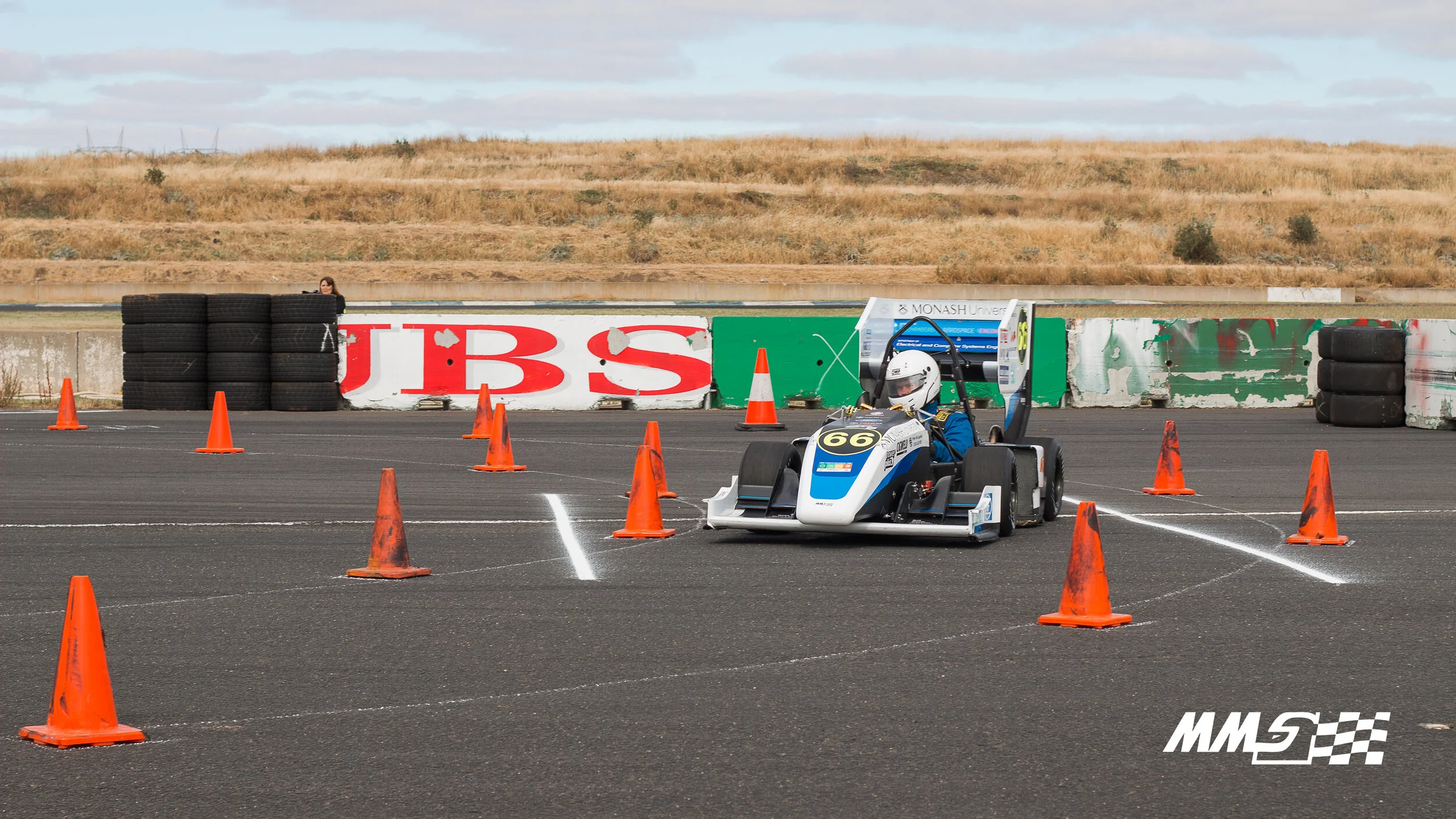VEHICLE SIMULATION FOR CONCEPT LEVEL DESIGN AND SPECIFICATION OF A FORMULA SAE RACECAR - Cameron Warne 2016
Monash Motorsport Final Year Thesis Collection
The Final Year Thesis, is a technical engineering assignment undertaken by students of Monash University. Monash Motorsport team members often choose to conduct this assignment in conjunction with the team.
These theses have been the cornerstone for much of the team’s success. The purpose of the team releasing the Monash Motorsport Final Year Thesis Collection is to share knowledge and foster progress in the Formula Student and Formula-SAE community.
We ask that you please do not contact the authors or supervisors directly, instead for any related questions please email info@monashmotorsport.com
Summary
Previous work done by Russouw, Bett, and Geist has produced a tyre model, competition simulator and a vehicle model. These three projects have previously been disjointed and have not significantly influenced the concept level design of Monash Motorsport Formula SAE racecars. This project developed and extended these three tools into a competition simulator that is built on a four wheeled, 3 degree of freedom vehicle model using a tyre model that has been fitted to available tyre testing data. This simulator was developed to include a graphical user interface, so that unfamiliar users will find it intuitive, easy and quick to use. The final part of this project is to apply the developed program and start using it to drive concept level design and specification of the 2017 Monash Motorsport cars. One of the investigations was energy management and aerodynamics of the 2017 electric car. The simulator was able to demonstrate that effective techniques could be used to reduce the battery consumption by up to 40% and that even with an aerodynamics package, reasonable energy usage levels can be achieved.
Introduction
Formula SAE is the largest student engineering competition in the world with over 500 universities participating. The competition is assessed on a point’s basis with 375 out of 1000 points allocated to static events where engineering design, cost effectiveness and a business presentation are assessed. The remaining 625 points are allocated to dynamic events which are composed of a straight line acceleration test, a cornering test, a one lap time trial and a 22km endurance event, where both speed and efficiency are assessed. The competition is also split into two categories, combustion cars which use four stroke internal combustion engines with up to 610cc displacement, and Electric cars with an 80 kW power limit. Previously the Monash Motorsport team has competed in just the combustion category but are currently developing an electric car to compete in 2017. This project is focused on developing tools to analyse the performance of the car in the dynamic events at a concept level for both the combustion and electric cars.
Previous team members have developed vehicle dynamic models and lap simulators to investigate the performance effects of different vehicle concepts. Steven Webb (2012), developed a point mass competition simulator that, given basic vehicle parameters such as mass, power, grip and aerodynamic coefficients, would simulate a car performing all five dynamic events. This was a basic but very useful tool for analysing broad vehicle concepts. Further final year projects expanded on this to develop more complex tools that could be used to better investigate vehicle parameters. Martin Bett (2015) developed a more complex competition simulator that incorporated additional vehicle parameters such as yaw acceleration, and vehicle acceleration limit surfaces. Marc Russouw (2014) developed a non dimensional tyre model for the Goodyear D2704s, which was used to better understand the tyre and its effect on car performance. Finally Michael Geist (2015) developed a four wheel, three degree of freedom vehicle model that simulates transient and steady state vehicle behavior, using Russouw’s tyre model. Even though the knowledge of vehicle dynamics within the Monash FSAE team has greatly improved due to the development of these tools they have not had a substantial effect on Monash Motorsport’s concept level design and vehicle specification.
The development and implementation of a combined simulator that uses all three tools would allow current and future members to evaluate concept level design decisions with great depth and accuracy. This program consists of a new, more versatile version of Russouw’s tyre model that can be quickly updated with new tyres, this feeds into Geist’s Vehicle model which will be used to create a performance envelope of the car. The performance envelope is then used by Bett’s competition simulator to determine the points effect of concept level design decisions.
Conclusion
The aim of this project was to develop a competition points simulator that was easy to use and could be used by future Monash Motorsport team members. Building on the work of Russouw, a tyre model that now is able to work with a range of tyres, and test data as well as fitting a function for the moments Mx, Mz and relaxation length. The new tyre model was then taken and implemented in a vehicle model based on the work of Geist, it was then thoroughly overhauled to achieve a 300x improvement in solve time. With the use of Davis Taylor’s limit surface pre-solving function, and lap time solver the vehicle model was used in conjunction with Bett’s code to create a competition simulator.
An integrated GUI environment was then created to tie together all the aspects of the simulator and make it easy to use and intuitive for future team members. The usability has been tested and was found to be extremely good with new users only 10-20% slower than an experienced user.
Finally the system was implemented to provide useful data for concept level decision making and has been used to investigate specifications that up until now the Monash Motorsport team has not had the tool to be able to do so.

